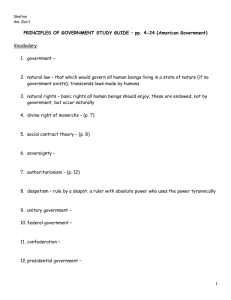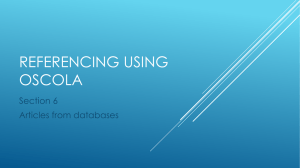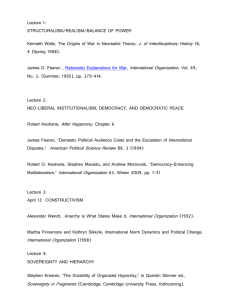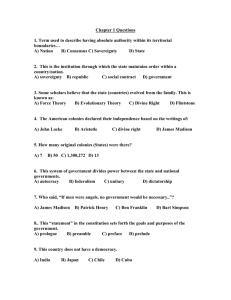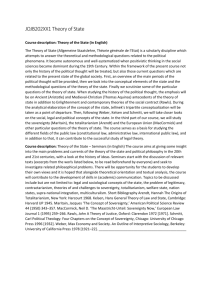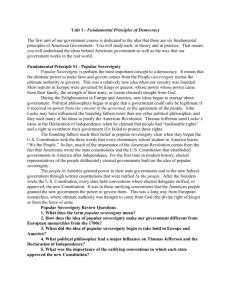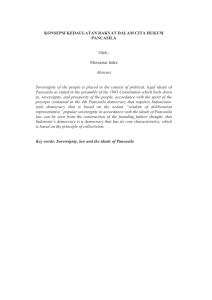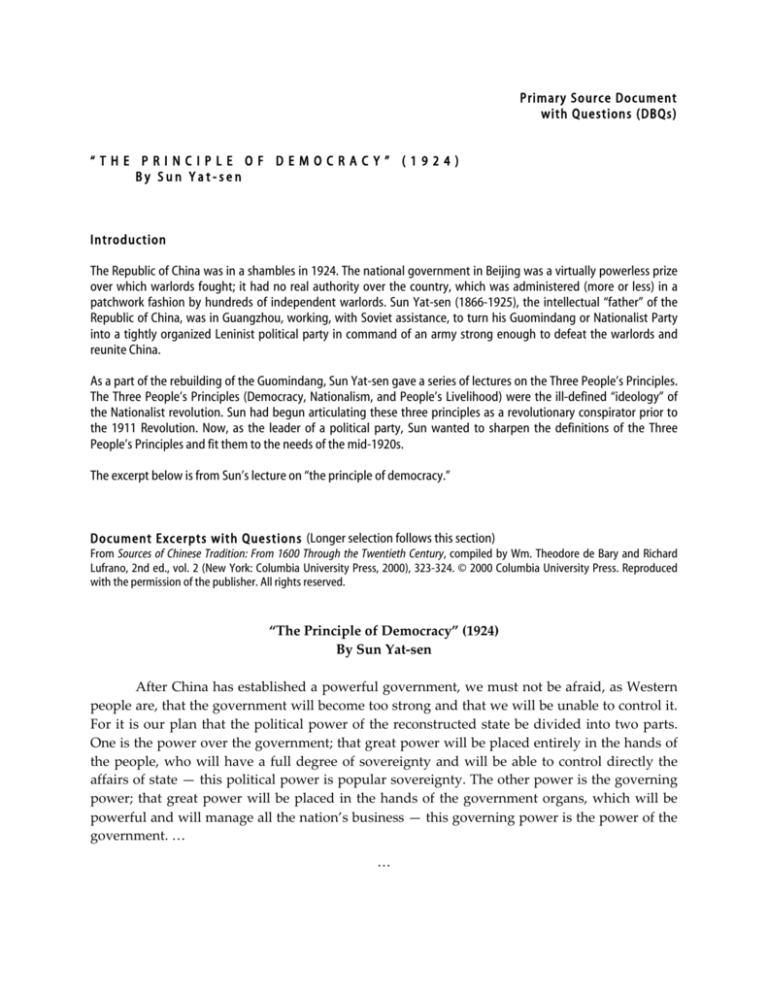
Primary Source Document
with Questions (DBQs)
“THE PRINCIPLE OF DEMOCRACY” (1924)
By Sun Yat-sen
Introduction
The Republic of China was in a shambles in 1924. The national government in Beijing was a virtually powerless prize
over which warlords fought; it had no real authority over the country, which was administered (more or less) in a
patchwork fashion by hundreds of independent warlords. Sun Yat-sen (1866-1925), the intellectual “father” of the
Republic of China, was in Guangzhou, working, with Soviet assistance, to turn his Guomindang or Nationalist Party
into a tightly organized Leninist political party in command of an army strong enough to defeat the warlords and
reunite China.
As a part of the rebuilding of the Guomindang, Sun Yat-sen gave a series of lectures on the Three People’s Principles.
The Three People’s Principles (Democracy, Nationalism, and People’s Livelihood) were the ill-defined “ideology” of
the Nationalist revolution. Sun had begun articulating these three principles as a revolutionary conspirator prior to
the 1911 Revolution. Now, as the leader of a political party, Sun wanted to sharpen the definitions of the Three
People’s Principles and fit them to the needs of the mid-1920s.
The excerpt below is from Sun’s lecture on “the principle of democracy.”
Document Excerpts with Questions (Longer selection follows this section)
From Sources of Chinese Tradition: From 1600 Through the Twentieth Century, compiled by Wm. Theodore de Bary and Richard
Lufrano, 2nd ed., vol. 2 (New York: Columbia University Press, 2000), 323-324. © 2000 Columbia University Press. Reproduced
with the permission of the publisher. All rights reserved.
“The
Principle
of
Democracy”
(1924)
By
Sun
Yat‑sen
After
China
has
established
a
powerful
government,
we
must
not
be
afraid,
as
Western
people
are,
that
the
government
will
become
too
strong
and
that
we
will
be
unable
to
control
it.
For
it
is
our
plan
that
the
political
power
of
the
reconstructed
state
be
divided
into
two
parts.
One
is
the
power
over
the
government;
that
great
power
will
be
placed
entirely
in
the
hands
of
the
people,
who
will
have
a
full
degree
of
sovereignty
and
will
be
able
to
control
directly
the
affairs
of
state
—
this
political
power
is
popular
sovereignty.
The
other
power
is
the
governing
power;
that
great
power
will
be
placed
in
the
hands
of
the
government
organs,
which
will
be
powerful
and
will
manage
all
the
nation’s
business
—
this
governing
power
is
the
power
of
the
government.
…
…
Primary Source Document, with Questions (DBQ) on
“THE PRINCIPLE OF DEMOCRACY” (1924), BY SUN YAT-SEN
What
are
the
newest
discoveries
in
the
way
of
exercising
popular
sovereignty?
First,
there
is
suffrage,
and
it
is
the
only
method
practiced
in
the
so‑called
democracies.
…
The
second
of
the
newly
discovered
methods
is
the
right
of
recall.
…
…
…
If
the
people
think
that
a
certain
law
would
be
of
great
advantage
to
them,
they
should
have
the
power
to
decide
upon
this
law
and
turn
it
over
to
the
government
for
execution.
This
third
kind
of
popular
power
is
called
initiative.
If
the
people
think
that
an
old
law
is
not
beneficial
to
them,
they
should
have
the
power
to
amend
it
and
to
ask
the
government
to
enforce
the
amended
law
and
do
away
with
the
old
law.
This
is
called
the
referendum
and
is
a
fourth
form
of
popular
sovereignty.
Questions:
1. Looking at it from Sun Yat-sen’s point of view in 1924, why should he want a
powerful government? Why does he contrast his desire with a Western fear
of powerful government?
2. Sun lays out four ways in which popular sovereignty will be exercised. Are
there ways in which popular sovereignty could be exercised that Sun fails to
mention? If so, why might he not mention them?
3. Considering the models of government available at the time (1924), which
other models around the world does Sun’s vision most closely resemble?
Why?
Longer Selection
From Sources of Chinese Tradition: From 1600 Through the Twentieth Century, compiled by Wm. Theodore de Bary and Richard
Lufrano, 2nd ed., vol. 2 (New York: Columbia University Press, 2000), 323-324. © 2000 Columbia University Press. Reproduced
with the permission of the publisher. All rights reserved.
“The
Principle
of
Democracy”
(1924)
By
Sun
Yat‑sen
Separation
of
Sovereignty
and
Ability
How
can
a
government
be
made
all‑powerful?
Once
the
government
is
all‑powerful,
how
can
it
be
made
responsive
to
the
will
of
the
people?
…
I
have
found
a
method
to
solve
the
problem.
The
method
that
I
have
thought
of
is
a
new
discovery
in
political
theory
and
is
a
fundamental
solution
of
the
whole
problem.
…
It
is
the
theory
of
the
distinction
between
sovereignty
and
ability.
After
China
has
established
a
powerful
government,
we
must
not
be
afraid,
as
Western
people
are,
that
the
government
will
become
too
strong
and
that
we
will
be
unable
to
control
it.
Asia for Educators | Columbia University | http://afe.easia.columbia.edu
Page 2 of 5
Primary Source Document, with Questions (DBQ) on
“THE PRINCIPLE OF DEMOCRACY” (1924), BY SUN YAT-SEN
For
it
is
our
plan
that
the
political
power
of
the
reconstructed
state
will
be
divided
into
two
parts.
One
is
the
power
over
the
government;
that
great
power
will
be
placed
entirely
in
the
hands
of
the
people,
who
will
have
a
full
degree
of
sovereignty
and
will
be
able
to
control
directly
the
affairs
of
state
—
this
political
power
is
popular
sovereignty.
The
other
power
is
the
governing
power;
that
great
power
will
be
placed
in
the
hands
of
the
government
organs,
which
will
be
powerful
and
will
manage
all
the
nation’s
business
—
this
governing
power
is
the
power
of
the
government.
If
the
people
have
a
full
measure
of
political
sovereignty
and
the
methods
for
exercising
popular
control
over
the
government
are
well
worked
out,
we
need
not
fear
that
the
government
will
become
too
strong
and
uncontrollable.
…
Let
the
people
in
thinking
about
government
distinguish
between
sovereignty
and
ability.
Let
the
great
political
force
of
the
state
be
divided
into
two:
the
power
of
the
government
and
the
power
of
the
people.
Such
a
division
will
make
the
government
the
machinery
and
the
people
the
engineer.
The
attitude
of
the
people
toward
the
government
will
then
resemble
the
attitude
of
the
engineer
toward
his
machine.
The
construction
of
machinery
has
made
such
advances
nowadays
that
not
only
men
with
mechanical
knowledge
but
even
children
without
any
knowledge
of
machinery
are
able
to
control
it.
The
Four
Powers
of
the
People
What
are
the
newest
discoveries
in
the
way
of
exercising
popular
sovereignty?
First,
there
is
suffrage,
and
it
is
the
only
method
practiced
throughout
the
so‑called
advanced
democracies.
Is
this
one
form
of
popular
sovereignty
enough
in
government?
This
one
power
by
itself
may
be
compared
to
the
earlier
machines,
which
could
move
forward
only
but
not
back.
The
second
of
the
newly
discovered
methods
is
the
right
of
recall.
When
the
people
have
this
right,
they
possess
the
power
of
pulling
the
machine
back.
These
two
rights
give
the
people
control
over
officials
and
enable
them
to
put
all
government
officials
in
their
positions
or
to
remove
them
from
their
positions.
The
coming
and
going
of
officials
follows
the
free
will
of
the
people,
just
as
the
modern
machines
move
to
and
fro
by
the
free
action
of
the
engine.
Besides
officials,
another
important
thing
in
a
state
is
law;
“with
men
to
govern
there
must
also
be
laws
for
governing.”1
What
powers
must
the
people
possess
in
order
to
control
the
laws?
If
the
people
think
that
a
certain
law
would
be
of
great
advantage
to
them,
they
should
have
the
power
to
decide
upon
this
law
and
turn
it
over
to
the
government
for
execution.
This
third
kind
of
popular
power
is
called
the
initiative.
If
the
people
think
that
an
old
law
is
not
beneficial
to
them,
they
should
have
the
power
to
amend
it
and
to
ask
the
government
to
enforce
the
amended
law
and
do
away
with
the
old
law.
This
is
called
the
referendum
and
is
a
fourth
form
of
popular
sovereignty.
Probably
a
reference
to
Huang
Zongxi,
whose
writings
on
rulership
and
law
Sun
had
reprinted
and
widely
distributed.
1
Asia for Educators | Columbia University | http://afe.easia.columbia.edu
Page 3 of 5
Primary Source Document, with Questions (DBQ) on
“THE PRINCIPLE OF DEMOCRACY” (1924), BY SUN YAT-SEN
Only
when
the
people
have
these
four
rights
can
we
say
that
democracy
is
complete,
and
only
when
these
four
powers
are
effectively
applied
can
we
say
that
there
is
a
thoroughgoing,
direct,
and
popular
sovereignty.
The
Five‑Power
Constitution
With
the
people
exercising
the
four
great
powers
to
control
the
government,
what
methods
will
the
government
use
in
performing
its
work?
In
order
that
the
government
may
have
a
complete
organ
through
which
to
do
its
best
work,
there
must
be
a
five‑power
constitution.
A
government
is
not
complete
and
cannot
do
its
best
work
for
the
people
unless
it
is
based
on
the
five‑power
constitution
[i.e.,
a
government
composed
of
five
branches:
executive,
legislative,
judicial,
civil
service
examination,
and
censorate].
…
All
governmental
powers
were
formerly
monopolized
by
kings
and
emperors,
but
after
the
revolutions
they
were
divided
into
three
groups.
Thus
the
United
States,
after
securing
its
independence,
established
a
government
with
three
coordinate
departments.
The
American
system
achieved
such
good
results
that
it
was
adopted
by
other
nations.
But
foreign
governments
have
merely
a
triple‑power
separation.
Why
do
we
now
want
a
separation
of
five
powers?
What
is
the
source
of
the
two
new
features
in
our
five‑power
constitution?
The
two
new
features
come
from
old
China.
China
long
ago
had
the
independent
systems
of
civil
service
examination
and
censorate,
and
they
were
very
effective.
The
imperial
censors
of
the
Manchu
dynasty
and
the
official
advisers
of
the
Tang
dynasty
made
a
fine
censoring
system.
The
power
of
censorship
includes
the
power
to
impeach.
Foreign
countries
also
have
this
power,
only
it
is
placed
in
the
legislative
body
and
is
not
a
separate
governmental
power.
The
selection
of
real
talent
and
ability
through
examinations
has
been
characteristic
of
China
for
thousands
of
years.
Foreign
scholars
who
have
recently
studied
Chinese
institutions
highly
praise
China’s
old
independent
examination
system.
There
have
been
imitations
of
the
system
for
the
selection
of
able
men
in
the
West.
Great
Britain’s
civil
service
examinations
are
modeled
after
the
old
Chinese
system,
but
they
are
limited
to
ordinary
officials.
The
British
system
does
not
yet
possess
the
spirit
of
the
independent
examination
of
China.
In
old
China,
[however],
…
the
powers
of
civil
service
examination
and
the
censorate
were
independent
of
the
Throne.
…
Hence,
as
for
the
separation
of
governmental
powers,
we
can
say
that
China
had
three
coordinate
departments
of
government
just
as
the
modern
democracies.
China
practiced
the
separation
of
autocratic,
examination,
and
censorate
powers
for
thousands
of
years.
Western
countries
have
practiced
the
separation
of
legislative,
judicial,
and
executive
powers
for
only
a
little
over
a
century.
However,
if
we
now
want
to
combine
the
best
from
China
and
the
best
from
other
countries
and
guard
against
all
kinds
of
abuse,
we
must
take
the
three
Western
governmental
powers
—
the
executive,
legislative,
and
judicial
—
add
to
them
the
Chinese
powers
of
examination
and
censorate
and
make
a
perfect
government
of
five
powers.
Such
a
Asia for Educators | Columbia University | http://afe.easia.columbia.edu
Page 4 of 5
Primary Source Document, with Questions (DBQ) on
“THE PRINCIPLE OF DEMOCRACY” (1924), BY SUN YAT-SEN
government
will
be
the
most
complete
and
the
finest
in
the
world,
and
a
state
with
such
a
government
will
indeed
be
of
the
people,
by
the
people,
and
for
the
people.
Asia for Educators | Columbia University | http://afe.easia.columbia.edu
Page 5 of 5


